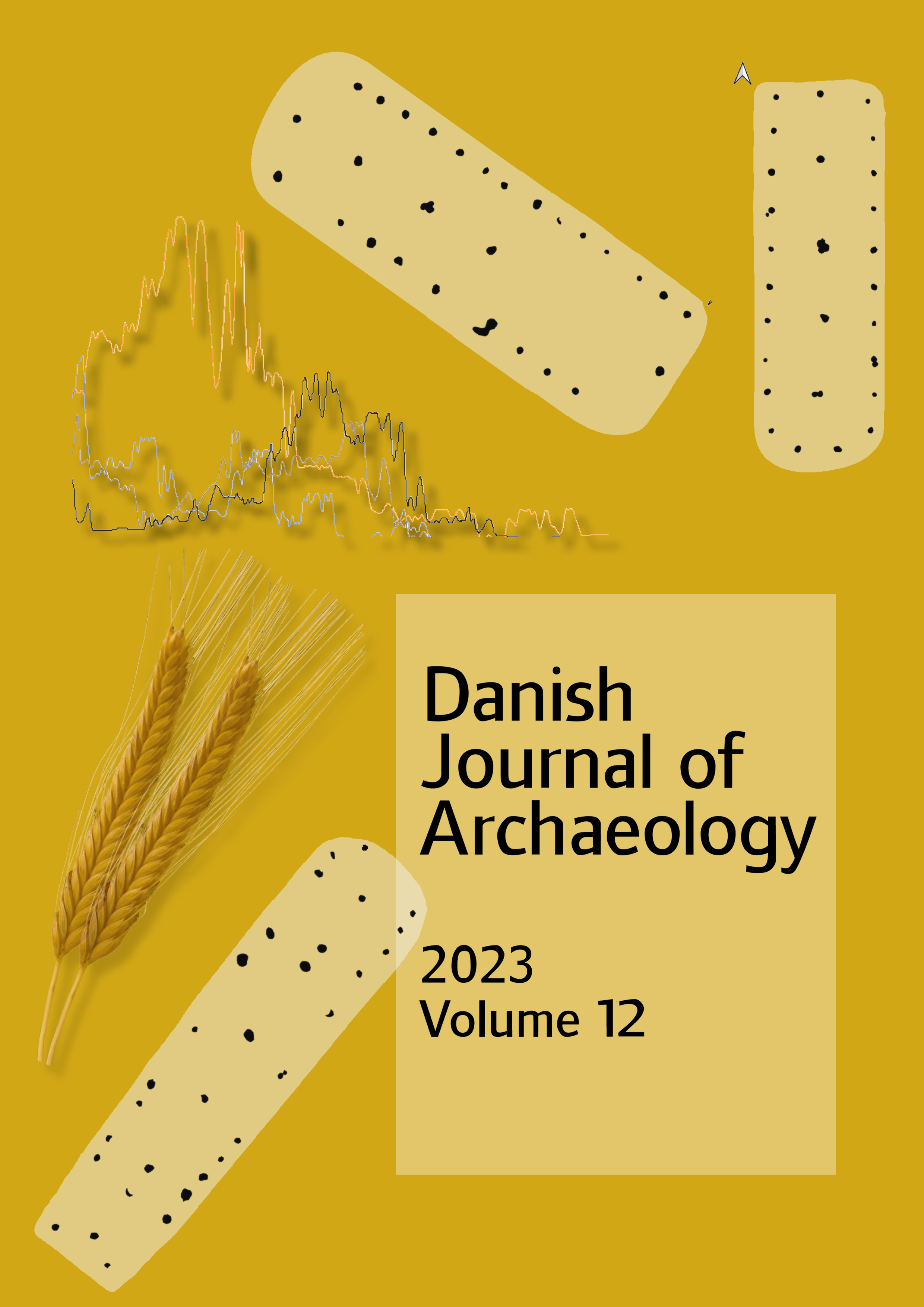Re-evaluating ‘Denmark’s Stonehenge’
Bronze Age communal activities in a distinctive landscape setting
DOI:
https://doi.org/10.7146/dja.v12i1.133824Keywords:
Circle structures, crop marks, fire pit clusters, Bronze Age, archaeological interpretation, ground-penetrating radarAbstract
In 1965, an aerial photograph from eastern Denmark revealed three concentric circles surrounding a large hill. In the following years, the National Museum conducted two small excavations, which seemed to confirm that these circular marks reflected concentric circles of features and large stone holes, but the reports were never completed. The site was later classified as a ‘stone- or woodhenge’.
In this paper we assess the interpretation of the aerial photograph and archaeological features around the prominent hill based on a re-excavation and ground-penetrating radar survey of a part of the site. While no circular structures can be identified, we argue that clusters of fire pits at the side of the steep hill represent communal activities from the Bronze Age, which combines the transformative elements of fire with the distinctive landscape of the large hill and the surrounding burial monuments. The site thereby serves as an example that links prominent hilltops surrounded by burial mounds, with the event of establishing fire pits in clusters.
References
Claudi-Hansen, L., 2021a. MVE03541-2 Overdrevsbakken. Beretning for arkæologisk undersøgelse. Museum Vestsjælland.
Claudi-Hansen, L., 2021b. MVE04039-2 Boeslunde Syd. Beretning for arkæologisk undersøgelse af to kogegrubefelter i Boeslunde nær votivfund og bopladsaktiviteter fra yngre bronzealder. Museum Vestsjælland.
Flohr Sørensen, T. and Bille, M., 2008. Flames of Transformation: The Role of Fire in Cremation Practices. World Archaeology 40:2. 253-67.
Henriksen, M. B., 2005. Danske kogegruber og kogegrubefelter fra yngre bronzealder og ældre jernalder. In: L. Gustafson, T. Heibreen and J. Martens (eds). De Gåtefulle Kogegroper. Varia 58. Oslo: Kulturhistorisk museum, 77-102.
Jensen, J., 2002. Danmarks Oldtid. Bronzealder 2000-500 f. Kr. København.
Kristensen, I. K., 2008. Kogegruber – i klynger og på rad og række. Kuml 2008, 9-52. https://doi.org/10.7146/kuml.v57i57.24655
Løvschal, M. and Fontijn, D., 2019. Directionality and axiality in the Bronze Age: Cross-regional landscape perspectives on ´fire pit lines´and other pitted connections. World Archaeology, 51:1. 140-156. https://doi.org/10.1080/00438243.2018.1488609
Martens, J., 2005. Kogegruber i syd og nord – samme sag? Består kogegrubefelter bare af kogegruber? In: L. Gustafson, T. Heibreen and J. Martens (eds). De Gåtefulle Kogegroper. Varia 58. Oslo: Kulturhistorisk museum, 37-56.
Ramskou, T., 1970. Et dansk Stonehenge? Nationalmuseets Arbejdsmark 1970, 59-66.
Ramskou, T., 1972. Cirklerne ved Birkendegård. Fra Holbæk Amt. Årbog for Historisk samfund for Holbæk Amt. 1971-72. 11-18.
Schaefer-Di Maida, S., 2022. Current Research on Bronze Age ‘Cooking Stone Pits’ in Northern Germany and Southern Scandinavia. European Journal of Archaeology 25/4. 463-482. https://doi.org/10.1017/eaa.2022.19
Stamnes, A. A., 2021. Arkæologisk georadarundersøkelse ved Overdrevsbakken, Værslev Sogn, Skippinge herred. Danmark. NTNU Vitenskapsmuseet arkaeologisk rapport 2021:19.
Downloads
Published
How to Cite
Issue
Section
License
Copyright (c) 2023 Lone Claudi-Hansen, Arne Anderson Stamnes

This work is licensed under a Creative Commons Attribution-NonCommercial-ShareAlike 4.0 International License.
Counting from volume 11 (2022), articles published in DJA are licensed under Attribution-NonCommercial-ShareAlike 4.0 International (CC BY-NC-SA 4.0). The editorial board may accept other Creative Commons licenses for individual articles, if required by funding bodies e.g. the European Research Council. With the publication of volume 11, authors retain copyright to their articles and give DJA the right to the first publication. The authors retain copyright to earlier versions of the articles, such as the submitted and the accepted manuscript.
Articles in volume 1-8 are not licensed under Creative Commons. In these volumes, all rights are reserved to DJA. This implies that readers can download, read, and link to the articles, but they cannot republish the articles. Authors can upload their articles in an institutional repository as a part of a green open access policy.
Articles in volume 9-10 are not licensed under Creative Commons. In these volumes, all rights are reserved to the authors of the articles respectively. This implies that readers can download, read, and link to the articles, but they cannot republish the articles. Authors can upload their articles in an institutional repository.





